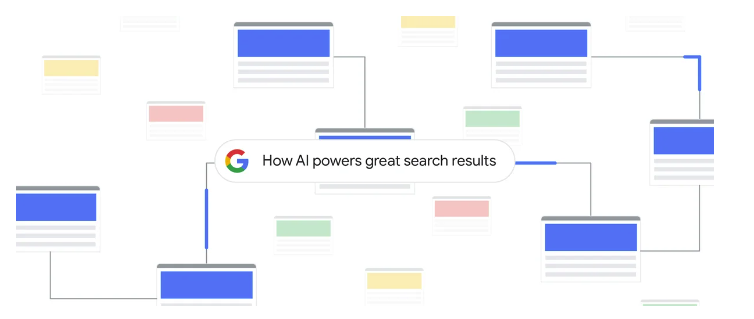The Dynamics of Google Search Listings

Unveiling the Role of SEO, User Preferences, and Google’s Influence
In the vast landscape of the internet, Google Search stands as the go-to gateway for information retrieval, shaping our online experience. Currently, Google has ~91% marketshare world-wide, meaning optimizing for their platform is vital to digital success across industries and verticals. However, the process of generating search result listings is not as straightforward as it may seem. Recent insights shed light on the intricate dance between search engine optimization (SEO), user preferences, and Google’s right to influence search listings.
This starts with understanding how businesses can influence search results and how Google (Bing, and other search platforms) use personalized data to determine both the results on the page (SERP) as well as how those results look and read.
Google disclaimer about their policy around listings and their right to build listings, note this page accurately uses the work “influence”, as SEO is optimization to influence results:
A title link is the title of a search result on Google Search and other properties (for example, Google News) that links to the web page. Google uses a number of different sources to automatically determine the title link, but you can indicate your preferences by following our best practices for influencing title links.
On the user side, they use non-personalized and personalized data (from Google’s “How Search Works“):
Information such as your location, past Search history, and Search settings all help us to ensure your results are what is most useful and relevant for you in that moment.
So, what should businesses know about their search results and how search works? Here are a few points to consider as you evaluate your search results, SEO practices, and consider solutions to leverage organic search for your benefit.
Google’s Right to Shape Listings
In a nutshell, Google retains the right to construct titles and descriptions or subtly tweak search result listings to better “represent” a specific webpage. This is rooted in their policy, as the results are technically property of Google, with the aim of enhancing user experience by tailoring search results to individual queries and search histories.
Understanding the Influence: SEO, User Data, and Search History
SEO, often seen as the art of optimizing content to improve its visibility in search engine results, plays a pivotal role in this dynamic. Websites and content creators employ strategies to influence how Google interprets and presents their pages. The Yoast SEO plugin in WordPress, for instance, provides a preview of the expected Search Engine Results Page (SERP) listing based on the entered title and description.
However, Google’s right to shape listings may come from their algorithm and database, but may extend beyond. The search engine utilizes an array of sources to automatically determine descriptions and title links, considering factors such as user location, past search history, and search settings.

Google relies on RankBrain (context machine learning AI) to determine some relevancy and context. For example, RankBrain is responsible for things such as the algorithm’s ability to ‘understand’ that SEO = Search Engine Optimization and visa versa. Location, search history, and search settings collectively contribute to RankBrain, and other algorithm systems, to ensuring that users receive content that is most useful to them in the given context.
While Google and other platforms promote that they do not influence organic search based on paid search investment or for their own profitability, some speculate that there are indicators to the contrary.
The User’s Side of the Equation
On the user side, personalization is evident as search users are able to control how search works for them and what data the search system can use and/or access. By utilizing information such as location, past search history, and search settings, the search engine can tailor results to meet the specific needs and interests of individual users.
For instance, if you’re in Chicago and search for “football,” Google says in ‘How Search Works’, “it is likely to prioritize results related to American football and the Chicago Bears. Conversely, searching for “football” in London will yield results focused on soccer and the Premier League.” These nuances highlight the intricate interplay between user preferences and Google’s algorithmic decisions.
Exploring Further: Google’s Best Practices for Influencing SERPs & SEO
Acknowledging that users and content creators might seek to influence search result listings, Google provides best practices for optimizing title links and descriptions. Reviewing these practices, third-party resources, and the latest algorithm updates, SEOs can ensure strategies align with their best practices and optimize web pages for maximum SERP potential. Simply put SEO’s goal is to enhance the likelihood of content appearing in a specific manner on search result pages.
For those interested in delving deeper into the mechanics of Google’s search result listings, the Google Search Help Center offers valuable insights.
Conclusion
In the ever-evolving landscape of online search, understanding the dynamics between SEO, user preferences, and Google’s influence on search listings is paramount. As users, it’s essential to be aware of the personalized nature of search results and the factors that contribute to the unique listings we encounter. Meanwhile, businesses and content creators can leverage SEO strategies and adhere to best practices to optimize their online presence in the eyes of the omnipotent search engine, Google.
—
Additional References:
- Why your Google Search results might differ from other people: https://support.google.com/
websearch/answer/12412910?hl= en - https://moz.com/blog/google-
modifying-searches - Personalization in search: https://support.google.com/
websearch/answer/12410098?hl= en
